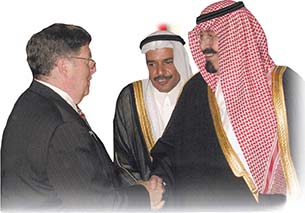SECTION 3: Global Politics and Economics

▲ Former White House official John Sununu meets with Saudi Arabian government leaders at a dinner during the Millennium Summit in New York City in 2000.
WITNESS HISTORY  AUDIO
AUDIO
Calling for a “Shared Future”
In 2000, the United Nations launched the Millennium Summit. The three-day event, held in New York City, was the largest gathering of world leaders in history. In the Millennium Declaration, they stated:
“We believe that the central challenge we face today is to ensure that globalization becomes a positive force for all the world’s people. For while globalization offers great opportunities, at present its benefits are very unevenly shared, while its costs are unevenly distributed…. [O]nly through broad and sustained efforts to create a shared future, based upon our common humanity in all its diversity, can globalization be made fully inclusive and equitable.”
—Millennium Declaration, September 8, 2000
Objectives
- Analyze how the United States responded to changes in the global economy.
- Assess the foreign policy goals and actions of the Clinton administration.
- Describe U.S. relations with various Middle Eastern countries and groups.
Terms and People
- EU
- NAFTA
- GATT
- WTO
- ethnic cleansing
- al Qaeda
NoteTaking
Reading Skill: Identify Main Ideas Complete a flowchart like this one to help you identify main ideas about global politics and economics.

Why It Matters With the end of the Cold War, the United States was the sole superpower in a dramatically changing world. No longer defined by its opposition to communism, the United States had to carve out new roles for itself in a world of globalization and increasing regional conflict. President Clinton, the nation’s first baby-boomer President, ushered in this new period of American soul-searching. Section Focus Question: What role did the United States take on in global politics and economics following the Cold War?
Competing in the Global Economy
In the 1990s, the United States was both an important promoter of global trade and an example for newly industrializing nations. As more nations participated in economic globalization, the United States tinkered with its own policies to ensure it remained an economic powerhouse.
The Role of Free Trade
As an economic leader, America has had a major role in globalization. Free trade—the guiding principle of globalization—has been hotly debated in American politics. Americans want the lower costs that free trade creates but worry about the loss of American jobs to other countries. Generally, Republicans have supported the interests of big business and free trade agreements. Democrats have been more sympathetic to labor interests and have often opposed legislation that would cost American workers’ jobs. Depending on which party has been in power, free trade has either been encouraged or hindered.




